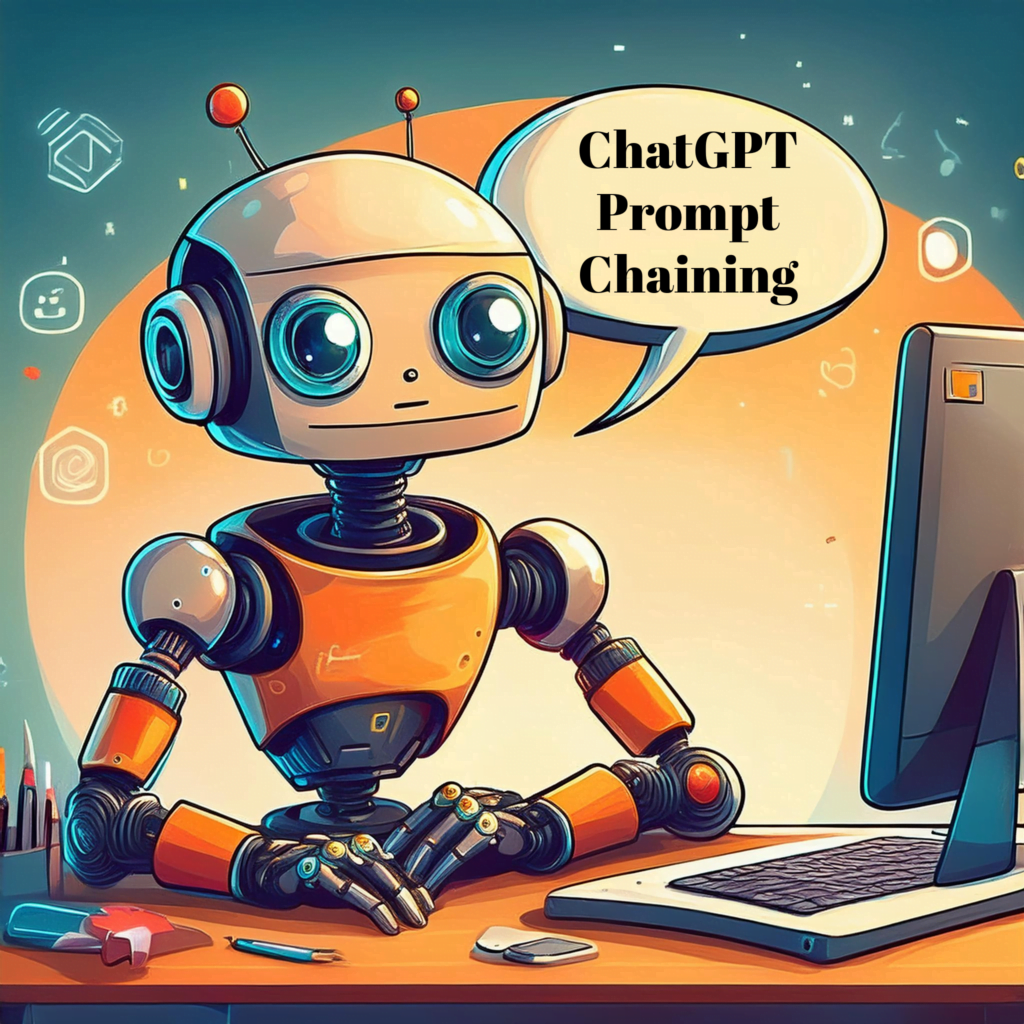Want to boost productivity? Master the art of prompt chaining to break tasks into manageable steps!

Think of this like planning a big road trip. Instead of just saying “Let’s drive across the country,” you break it down into smaller, manageable steps. In the AI world, this helps your digital buddy understand and tackle big tasks without getting overwhelmed.
For example, let’s say we want to write a short story:
- “Give me five interesting character ideas for a mystery story.”
- “For the retired detective character, describe their appearance and personality.”
- “Now, create a mysterious situation this detective might investigate.”
- “Describe the crime scene in detail.”
- “Finally, give me the story’s first paragraph introducing our detective and the crime scene.”
See how we’ve taken a big task (writing a story) and broken it into bite-sized chunks? This makes it easier for the AI to give us quality responses at each step.
Introduction to Prompt Chaining

One key technique to improve the reliability and performance of large language models (LLMs) is breaking tasks down into smaller, manageable subtasks. Once these subtasks are identified, the LLM is given one subtask at a time, and its response is used as input for the next step. This approach is known as “prompt chaining,” where the task is split into smaller pieces, creating a sequence of prompts.
Prompt chaining is especially useful for handling complex tasks that might overwhelm an LLM when given a single, highly detailed prompt. By breaking things down, each prompt in the chain can build on the last, helping refine and transform responses until they reach the desired result.
Beyond improving performance, prompt chaining adds transparency, making it easier to track and control how the LLM handles tasks. It allows you to spot issues in model responses more easily, which helps with debugging and improving specific stages that need fine-tuning.
This approach of prompt chaining is helpful when developing LLM-based conversational assistants, where it enhances personalisation and overall user experience by guiding the model through each step more effectively.
Let’s take a look at some of the benefits of prompt chaining:
| Benefit | Description | Example |
| Improved Performance | Breaking complex tasks into smaller subtasks helps the LLM manage them more effectively, reducing errors and improving accuracy. | Instead of asking the model to solve an entire math problem, break it down: first calculate the sum, then move on to multiplication |
| Increased Transparency | It becomes easier to see how the LLM arrives at its results, making it simpler to diagnose and fix errors at each stage. | When debugging a chatbot, you can analyze each step it takes in a conversation to find where the misunderstanding occurs. |
| Enhanced User Experience | By guiding the LLM step-by-step, users receive more accurate and personalized responses, leading to better interactions. | A customer service bot can first ask for the issue type, then request details, ensuring more relevant and precise support |
Managing context across multiple prompts
This is like having a great conversation with a friend where you don’t have to keep reminding them what you’re talking about. AI remembers what you’ve discussed and uses that information in later prompts.
Let’s plan a vacation using this technique:
- “Suggest five popular beach destinations in Europe.”
- “For the Greek Islands, what’s the best time of year to visit?”
- “What are three must-see attractions in this area?”
- “Recommend a local dish to try.”
- “Finally, give me a rough 3-day itinerary for this destination.”
Notice how after the second prompt, we didn’t need to specify “Greek Islands” again? The AI remembers the context, making our conversation flow naturally.
Practical exercise: Solving multi-step problems with prompt chains
Here’s how you can put this into practice with Python!
Step 1: Preparing the environment
To begin, we need to import the necessary libraries. We’ll use the OpenAI class from the openai package and os to manage environment variables.
import openai
import osIt’s important to store sensitive information, such as API keys, securely. A good approach is to set the API key as an environment variable, like the OpenAI API key.
os.environ['OPENAI_API_KEY'] = 'your-api-key-here'Make sure to replace ‘your-api-key-here’ with your actual OpenAI API key.
Once the API key is set, you can proceed to initialize the OpenAI client, which will be used to interact with OpenAI’s services.
Client = OpenAI ()Step 2: Creating a function to interact with OpenAI’s chat completions API
Next, we’ll define a Python function that communicates with OpenAI’s chat completions API. This function will send a prompt and return the generated response.
def get_completion(prompt, model="gpt-3.5-turbo"):
try:
response = client.chat.completions.create(
model=model,
messages=[
{"role": "system", "content": "You are a helpful assistant."},
{"role": "user", "content": prompt}
],
temperature=0,
)
return response.choices[0].message.content
except Exception as e:
print(f"An error occurred: {e}")
return NoneLet’s break down this function:
- It accepts a prompt and an optional model parameter.
- Sends a request to OpenAI through the chat completions endpoint.
- Initializes the conversation with a system message and the user’s prompt.
- Sets the temperature to 0 for more consistent responses (higher temperature for more creative results).
- Returns the content of the response, or None if an error happens.
Step 3: Linking multiple prompts
Next, we’ll develop a Python function that connects several prompts, using the output of one prompt as the input for the next.
def prompt_chain(initial_prompt, follow_up_prompts):
result = get_completion(initial_prompt)
if result is None:
return "Initial prompt failed."
print(f"Initial output: {result}\n")
for i, prompt in enumerate(follow_up_prompts, 1):
full_prompt = f"{prompt}\n\nPrevious output: {result}"
result = get_completion(full_prompt)
if result is None:
return f"Prompt {i} failed."
print(f"Step {i} output: {result}\n")
return resultThe prompt chain function handles prompt chaining as follows:
- Begins with an initial prompt and retrieves its completion.
- Loops through a list of follow-up prompts.
- For each follow-up, it merges the prompt with the previous output, gets a completion, and updates the result.
- If any step fails, it returns an error message.
- Each step’s output is printed for clarity.
Step 4: Example Usage
In this step, we’ll illustrate how to use the prompt chain function to create a series of interconnected prompts. The example will highlight summarizing key trends in global temperature changes and exploring associated scientific studies and mitigation strategies. Feel free to adapt this approach to fit your own needs!
initial_prompt = "Summarize the key trends in global temperature changes over the past century."
follow_up_prompts = [
"Based on the trends identified, list the major scientific studies that discuss the causes of these changes.",
"Summarize the findings of the listed studies, focusing on the impact of climate change on marine ecosystems.",
"Propose three strategies to mitigate the impact of climate change on marine ecosystems based on the summarized findings."
]
final_result = prompt_chain(initial_prompt, follow_up_prompts)
print("Final result:", final_result)In this section, we begin by defining an initial prompt focused on global temperature changes. We then create a sequence of follow-up prompts that build on each previous response. By using the `prompt chain` function with these prompts, we can generate a comprehensive result.
Here’s how it works:
1. The initial prompt provides a summary of temperature trends.
2. The first follow-up uses this summary to identify relevant studies.
3. The second follow-up summarizes the findings of these studies regarding marine ecosystems.
4. The final prompt integrates all this information to suggest effective mitigation strategies.
Quiz Time!
Which of the following is a benefit of prompt chaining?
- It allows AI to complete tasks faster without any steps
- It improves transparency and makes it easier to track how the AI arrives at results
- It eliminates the need for any follow-up prompts
- It only works for creative writing tasks
Do you feel like your AI’s answers are written by a cryptic poet? Learn how to craft prompts that get straight to the point, and ditch the drama!
Follow our LinkedIn page for never-ending AI and Tech updates!





